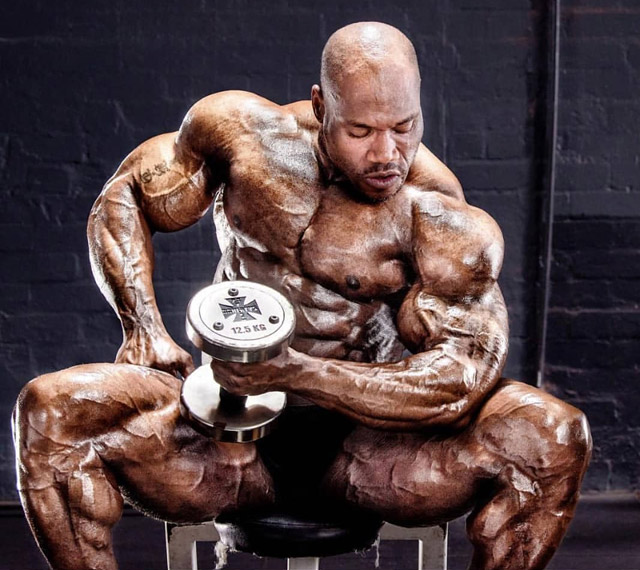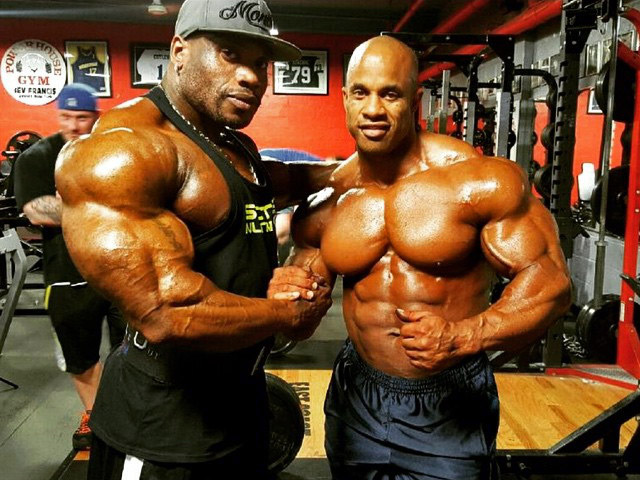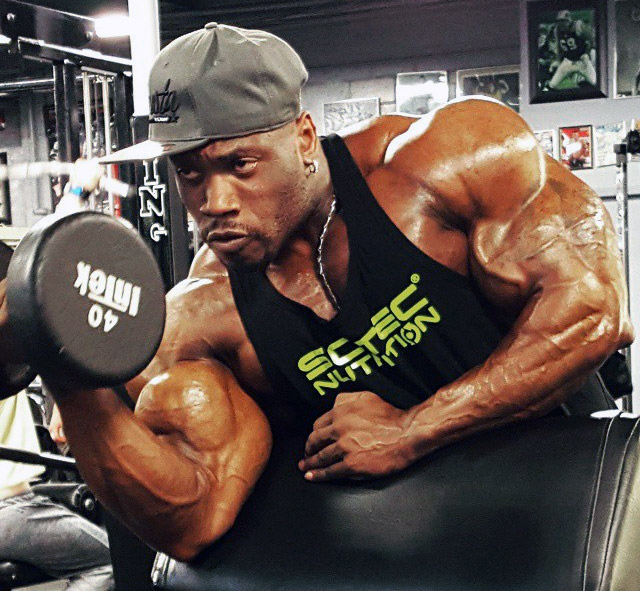The approach to Max Charles’s training is so distinctive and original, and it deviates from all experienced and traditional practices that I want to devote myself to it, as they say, to the third of all good things. After the training programs for the breasts and back , which I have addressed in the past in previous articles, this time I want to focus on the muscles of the arms.
Given the fact that Max Charles celebrated his forties this year, let’s take a brief look at his past and the beginning of his bodybuilding career. He was born on February 20, 1980 in Port-au-Prince, the capital of the small island state of Haiti in the Caribbean. With a population like our republic, the vast majority of which live below the poverty line, it is the poorest country on the American continent. No wonder, then, that when Max was one year old, his father went to work in the United States, regularly sending money to his family. He did not meet him until he was ten years old. As a child, Max ran to a nearby park every morning and met with athletes who were strengthening and lifting dumbbells, and of course he wanted to try it. His mother forbade him to do so, so he started playing football, which is Haiti’s national and most widespread sport (where not…). When he was 12, his family finally raised enough money to leave Haiti and move to Long Island east of New York, where Max still lives today. At first, it was difficult to adapt to the local significantly colder climate, which contrasted sharply with the very pleasant tropical climate in Haiti, but apart from the need to master English, it was probably the only negative of this life change. At the age of fourteen, he was inspired by Arnold and found other great role models in bodybuilding magazines: but apart from having to master English it was probably the only negative of this life change. At the age of fourteen, he was inspired by Arnold and found other great role models in bodybuilding magazines: but apart from having to master English it was probably the only negative of this life change. At the age of fourteen, he was inspired by Arnold and found other great role models in bodybuilding magazines: “I admired Shawn Ray for his impressive presentation of his muscles. He looked really perfect and extremely professional. Flex Wheeler had a very aesthetic figure and beautiful shapes. But my favorite professional was Kevin Levrone, so I wanted to look. He was just the biggest for me!
And so, as a young enthusiast, he tried to build muscles at home using push-ups and other exercises with his own body. When the neighbor saw him, he gave him a 10kg barbell that he didn’t need. He had the typical appearance of a teenager – thin, sinewy, but still muscular with a weight of 65 kg. When his mother saw his unquenchable passion for exercise, she took pity on him and at the age of fifteen finally let him into the gym with his friend. They practiced together for three months before their paths parted. At this time, he trained nothing but arms and breasts, every day. Fortunately, he soon realized the need to exercise his whole body, so he began training each muscle part three times a week. “I tried to get as much information as possible from older and more experienced exercisers. However, some clearly did not want to help me and deliberately gave me bad advice, others gave me advice that contradicted each other. It was not at all easy for me to distinguish false from correct information,” he recalls. to its beginnings Max. However, favorable genetics soon became apparent and by the age of nineteen he had already gained most of the muscle mass he has today. The main difference, however, was in the quality and detail of the muscle training. However, in the famous Bev’s and Steve’s Powerhouse Gym (owned by former excellent bodybuilder and powerlifter Bev Francis and her husband Steve Weinberger) in Syosset, Max had the opportunity to see a number of top professionals and amateurs in training, which motivated him to achieve goals that he resolved.
Finally, D-Day came. In the spring of 2008, he took the podium for the first time at the NPC Eastern USA competition, and his debut could not be better – he won in the toughest weight category. However, this was not a competition of national importance and it was still necessary to mature musically in order to dare for the NPC Nationals, ie the highest national competition. In 2011 he finally decided to participate and it was an excellent second place again in the heaviest weight. A year later, he finished “only” third at the US NPC with a body weight of 120 kg. So it seems that he has not been able to sufficiently turn quantity into quality. He finally survived in 2013, when he not only won the heaviest weight at the US National Championship, but also won the absolute title. And the door to the pros was open…
This culminated in his amateur career, but as a professional he was at the very beginning. He was aware of his shortcomings, he had enough muscle mass, but he needed to process it better and give her the necessary details and separation. However, what he had to work on the most were rather average legs, which contrasted sharply with the excellent upper half of the body. He avoided squat training for a long time due to the lower back area, which was prone to injuries. In addition, he was concerned that squat training would disproportionately increase his buttock muscles. He considered everything and decided to include squats in training. And he did well, his legs began to grow, but it took a long time for them to level with the upper half of his body.

New York Pro in May 2014 (here, Max appeared on the podium for the first time as a professional) was definitely one of the most impressive characters and got into the top five, yet this placement was a disappointment for him. He wanted more and trained very hard for it. Judge for yourself what it means “very hard” in his presentation. You will either call his actions meaningless, or you will shake your head in disbelief. Anyone who has read the last two articles about his trainings probably already knows what I’m talking about. Most bodybuilders, including professionals, train for 60 to 90 minutes. Max’s workouts, on the other hand, last three to three and a half hours without cardio, six times a week! What does it remind you of? Of course, “old school” trainings, including Arnold’s, which are now considered long overdue. “I just have a very high amount of training working on me, and the more I train, the more my muscles grow. I don’t care if anyone says I have to be overtrained. But it’s clear to me that for most people, my training practices are unacceptable and would not lead to the desired results, “ Max.
However, the way Max performs his repetition has also often been the subject of discussion and contradictory reactions. Max prefers a very short range of motion. Most exercises are about half the range of motion because they feel that the muscles are working at a constant maximum tension. He used to train with as much range of motion as possible, but once he tried a shorter range, he found that this principle brought him better results.
No one knows him better than his longtime friend Justin Miller, who claims that Max has the genetic potential for “God-given” muscle growth. One that no one has at all. Without these exceptional genes, his brutal training would be suicidal, but not for him. Purpose sanctifies the means, and Max, of course, wouldn’t do anything to waste time.
Max’s exceptional principles of arm development
Undoubtedly, Max proceeds in his own way in everything and does not care at all whether his procedures correspond to any norms or established habits. So below are some of his principles on which his arm training is based. We can discuss endlessly whether his methods make sense or not, but one thing is for sure – they work! The best proof is his arm dimensions, which in the volume period reach 58 cm!
High number of repetitions
It is a matter of opinion which range of repetitions is most suitable for arm development. Some prefer low numbers in the range of 4 to 6 repetitions, according to others the range of 15 to 20 repetitions is ideal for this relatively small muscle group.
Max goes even higher and usually completes 20 to 30 repetitions, but often even 40 to 50 repetitions. Of course, in the past, like everyone else, he had adhered to the standard lower number, but he found that this range of repetitions did not bring him any good results. “My procedure is certainly not the best method for everyone, but thanks to it, I will achieve the best possible muscle pumping,” praises Max.

High training volume
Just as there are different views on the number of repetitions, the same can be said about the number of sets, ie what number is ideal for arm training. Most bodybuilders use 12 to 20 series for both biceps and triceps, and usually fit in one hour. However, Max is in no hurry to end his training and is not afraid of a larger volume of training. “My goal is to load the arms until they are completely stiff and I can barely move with them,” he says, continuing, “It’s clear to me that for most exercisers, this approach would lead to overtraining. I can’t say if such training would “It was valid for others, and I’m not saying that other bodybuilders should train exactly like me. I’m just training in the way that gives me the best results.”
The principle of rest-pause or intermittent series
This is Max’s most popular intensification technique, which he calls “double series”, but we know this procedure more by the name above. This principle combines higher numbers of repetitions, which lead to maximum pumping, with an extreme accumulation of lactic acid in the working muscles, which leads to an unbearable burning sensation and the need to end the series. After reaching this state, it rests for 5 to 10 seconds and continues. In this way, he is able to perform often 25 to 30 repetitions with a weight that would normally only allow him about 15 repetitions. It classifies this principle much rather than reduced (multiple) series, because it does not have to reduce the weight used, and it considers this to be an advantage of this principle.
| exercise | series | repetition |
|---|---|---|
| biceps | ||
| biceps strokes standing with the lower pulley (facing the pulley) | 1 | 30 (warm-up) |
| biceps strokes standing with the lower pulley (facing the pulley) | 4 | 20 – 30 |
| biceps strokes standing with the lower pulley (back to the pulley) | 1 | 40 – 50 |
| pulling the pulley sitting down with a narrow touch | 3 | 16 – 30 |
| hammer strokes with rope or with single arms | 2 | 16 – 20 |
| biceps strokes one arm on Scott’s bench | 2 | 20 (each arm) |
| alternating biceps strokes with single arms | 2 | 20 – 30 |
| biceps strokes on a machine with elbows above shoulder level | 2 | 20 – 30 |
| biceps strokes on a machine with elbows below shoulder level | 2 | 20 – 30 |
| concentrated strokes one-handed sitting | 1 | 20 – 30 |
| triceps | ||
| triceps pulling the pulley in a standing position with a straight axis | 5 intermittent series | 25 – 30 |
| triceps pulling pulley with rope adapter | 7 intermittent series | 25 – 30 |
| French pressures lying down with one arms | 3 intermittent series | |
| cranks on the machine | 3 intermittent series | |
| kick-back with one-handed pulley | 1 | 40 – 50 |
Comment
One intermittent series in Max’s design means to perform 15 – 20 repetitions continuously (simply until exhaustion), rest for 5 to 10 seconds and complete the series with another 10 – 15 repetitions.
Of course, this training is not intended for beginners, but if you have a problem with the development of the arms and you have tried the usual procedures that did not bring you the desired results, then why not experiment and try Max Charles training? You won’t lose anything by that and maybe his training will suit you, you never know.
Mr. Olympia 2020 is fast approaching and Max Charles will certainly try to improve his reputation and position compared to last year’s unflattering 13th place. His starting position is not bad, because he secured his place in the championship. Well, let’s see if his non-traditional training practices will celebrate success!

